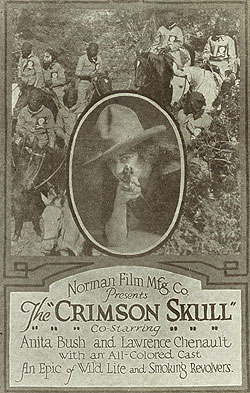Persons interested in how African-Americans have been portrayed in film have a new resource to explore thanks to University Libraries’ acquisition of a rich collection of materials used in promoting films.
The collection can be a valuable research tool for teaching or researching in any of several areas, including film studies, African and African-American studies, American culture studies, history, education, psychology and sociology.

The Black Film Promotional Materials Collection comprises some 2,700 posters, programs, photographs, advertisements, press kits and other materials used to promote more than 400 films between 1915-1980. The collection is housed at University Archives in the West Campus Library and can be accessed by University faculty, students and staff, as well as by researchers not affiliated with WUSTL.
“The libraries’ film and media archives have incredibly rich holdings in documentary filmmaking, particularly in films made from the 1960s through the late 1980s by African-American filmmaker Henry Hampton, a Washington University alumnus,” said B.J. Johnston, associate dean of collections for the libraries. “The Black Film Promotional Materials Collection strengthens our existing collections by adding another dimension.”
University faculty members voiced support of the acquisition.
“This exceptional collection is a wonderful complement to the Hampton Collection,” said John Baugh, Ph.D., the Margaret Bush Wilson Professor in Arts & Sciences and director of African and African American Studies in Arts & Sciences. “In the spirit of Spike Lee’s work, many of these artifacts will affirm various stages of racism and (show) the promotion of African-Americans in the entertainment industry.”
The collection offers “great visual material to help students think about the representation of African-Americans in the 20th century in a pervasive and powerful medium,” said Joseph Thompson, assistant professor of English in Arts & Sciences and of African and African American Studies.
Among the rarer items in the collection are materials related to films made before 1950, including The Birth of a Nation (1915), Cabin in the Sky (1941) and Stormy Weather (1943).
The collection also includes materials for films made with all-African-American casts by small, independent companies, including a number of exceptionally rare pieces from the silent films of the 1920s.
The collection offers extensive materials from popular movies such as No Way Out (1950), Carmen Jones (1954), The Defiant Ones (1958), In the Heat of the Night (1967) and Guess Who’s Coming to Dinner (1968). Materials related to 1970s blaxploitation films are particularly rich.
Nearly all prominent African-American actors, directors and writers of several decades appear in the collection. There are extensive materials on Sidney Poitier, Ossie Davis, Harry Belafonte, Dorothy Dandridge and many others.
The collection is rich in materials from nearly all the films of actor and singer Paul Robeson, including Showboat (1936), Emperor Jones (1935) and King Solomon’s Mines (1937).
Rare materials on legendary film pioneers Lena Horne, Rex Ingram, Oscar Micheaux, Mantan Moreland and the Nicholas Brothers enrich the collection.
Also included are materials for films that feature appearances by Bill “Bojangles” Robinson; these include In Old Kentucky (1935) and Stormy Weather (1943). Materials supporting Joe Louis’ movie Roar of the Crowd (1938) are included, too.
The collection documents film appearances by musical greats Louis Armstrong, Pearl Bailey, Cab Calloway, Nat King Cole, Duke Ellington, Billie Holiday and Eartha Kitt.
Most of the films are American-made, but there are some rare holdings from the United Kingdom, Denmark, France, Germany, Poland, Romania, Latin America and Australia.
A detailed guide to the Black Film Promotional Materials Collection is available online at library.wustl.edu/units/spec/archives/guides/pdf/black-film.pdf. It includes an alphabetical listing of the films, complete with credits as well as an outline of the collection.
University Archives is open from 8:30 a.m.-5 p.m. Monday-Friday, except for University holidays.
For more information about accessing the materials, call 935-5444 or 935-9730 or e-mail spec@wumail.wustl.edu.